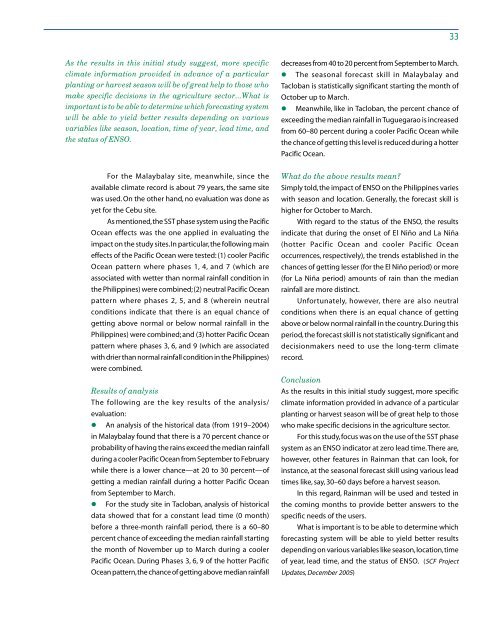Read More - Philippine Institute for Development Studies
Read More - Philippine Institute for Development Studies
Read More - Philippine Institute for Development Studies
Create successful ePaper yourself
Turn your PDF publications into a flip-book with our unique Google optimized e-Paper software.
33<br />
As the results in this initial study suggest, more specific<br />
climate in<strong>for</strong>mation provided in advance of a particular<br />
planting or harvest season will be of great help to those who<br />
make specific decisions in the agriculture sector...What is<br />
important is to be able to determine which <strong>for</strong>ecasting system<br />
will be able to yield better results depending on various<br />
variables like season, location, time of year, lead time, and<br />
the status of ENSO.<br />
decreases from 40 to 20 percent from September to March.<br />
• The seasonal <strong>for</strong>ecast skill in Malaybalay and<br />
Tacloban is statistically significant starting the month of<br />
October up to March.<br />
• Meanwhile, like in Tacloban, the percent chance of<br />
exceeding the median rainfall in Tuguegarao is increased<br />
from 60–80 percent during a cooler Pacific Ocean while<br />
the chance of getting this level is reduced during a hotter<br />
Pacific Ocean.<br />
For the Malaybalay site, meanwhile, since the<br />
available climate record is about 79 years, the same site<br />
was used. On the other hand, no evaluation was done as<br />
yet <strong>for</strong> the Cebu site.<br />
As mentioned, the SST phase system using the Pacific<br />
Ocean effects was the one applied in evaluating the<br />
impact on the study sites. In particular, the following main<br />
effects of the Pacific Ocean were tested: (1) cooler Pacific<br />
Ocean pattern where phases 1, 4, and 7 (which are<br />
associated with wetter than normal rainfall condition in<br />
the <strong>Philippine</strong>s) were combined; (2) neutral Pacific Ocean<br />
pattern where phases 2, 5, and 8 (wherein neutral<br />
conditions indicate that there is an equal chance of<br />
getting above normal or below normal rainfall in the<br />
<strong>Philippine</strong>s) were combined; and (3) hotter Pacific Ocean<br />
pattern where phases 3, 6, and 9 (which are associated<br />
with drier than normal rainfall condition in the <strong>Philippine</strong>s)<br />
were combined.<br />
Results of analysis<br />
The following are the key results of the analysis/<br />
evaluation:<br />
• An analysis of the historical data (from 1919–2004)<br />
in Malaybalay found that there is a 70 percent chance or<br />
probability of having the rains exceed the median rainfall<br />
during a cooler Pacific Ocean from September to February<br />
while there is a lower chance—at 20 to 30 percent—of<br />
getting a median rainfall during a hotter Pacific Ocean<br />
from September to March.<br />
• For the study site in Tacloban, analysis of historical<br />
data showed that <strong>for</strong> a constant lead time (0 month)<br />
be<strong>for</strong>e a three-month rainfall period, there is a 60–80<br />
percent chance of exceeding the median rainfall starting<br />
the month of November up to March during a cooler<br />
Pacific Ocean. During Phases 3, 6, 9 of the hotter Pacific<br />
Ocean pattern, the chance of getting above median rainfall<br />
What do the above results mean<br />
Simply told, the impact of ENSO on the <strong>Philippine</strong>s varies<br />
with season and location. Generally, the <strong>for</strong>ecast skill is<br />
higher <strong>for</strong> October to March.<br />
With regard to the status of the ENSO, the results<br />
indicate that during the onset of El Niño and La Niña<br />
(hotter Pacific Ocean and cooler Pacific Ocean<br />
occurrences, respectively), the trends established in the<br />
chances of getting lesser (<strong>for</strong> the El Niño period) or more<br />
(<strong>for</strong> La Niña period) amounts of rain than the median<br />
rainfall are more distinct.<br />
Un<strong>for</strong>tunately, however, there are also neutral<br />
conditions when there is an equal chance of getting<br />
above or below normal rainfall in the country. During this<br />
period, the <strong>for</strong>ecast skill is not statistically significant and<br />
decisionmakers need to use the long-term climate<br />
record.<br />
Conclusion<br />
As the results in this initial study suggest, more specific<br />
climate in<strong>for</strong>mation provided in advance of a particular<br />
planting or harvest season will be of great help to those<br />
who make specific decisions in the agriculture sector.<br />
For this study, focus was on the use of the SST phase<br />
system as an ENSO indicator at zero lead time. There are,<br />
however, other features in Rainman that can look, <strong>for</strong><br />
instance, at the seasonal <strong>for</strong>ecast skill using various lead<br />
times like, say, 30–60 days be<strong>for</strong>e a harvest season.<br />
In this regard, Rainman will be used and tested in<br />
the coming months to provide better answers to the<br />
specific needs of the users.<br />
What is important is to be able to determine which<br />
<strong>for</strong>ecasting system will be able to yield better results<br />
depending on various variables like season, location, time<br />
of year, lead time, and the status of ENSO. (SCF Project<br />
Updates, December 2005)










